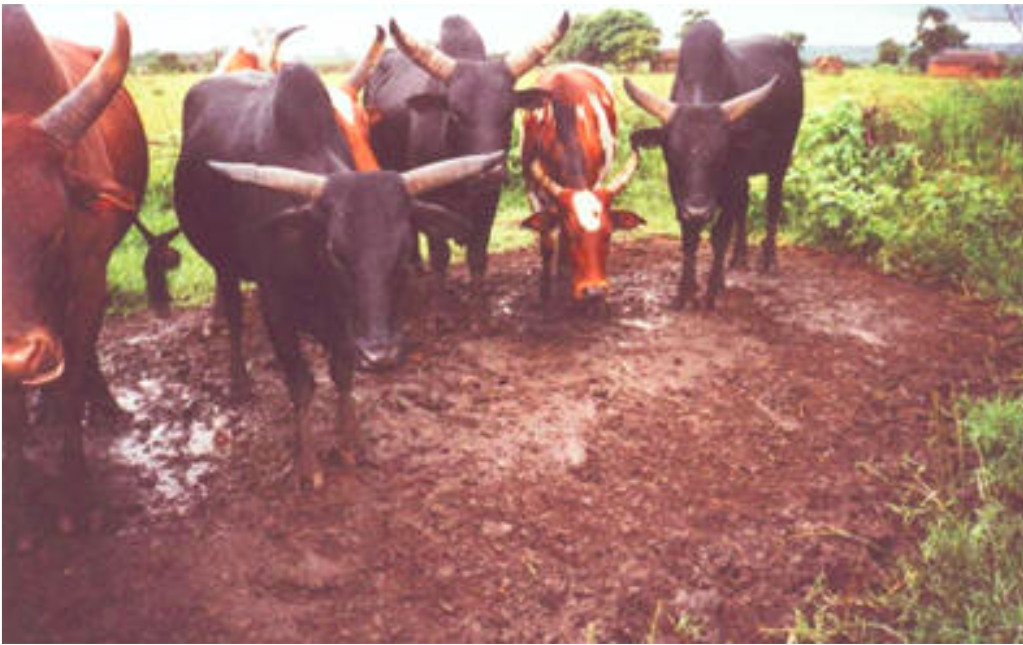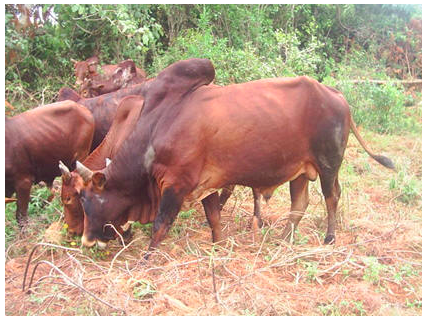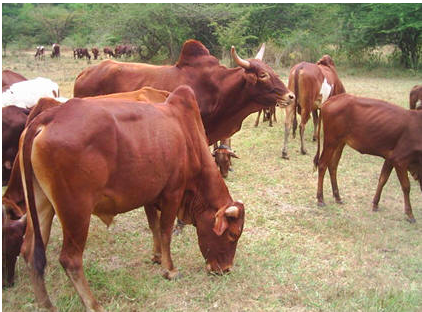The study considered two cattle strains which have been raised by the indigenous people for many years. The study areas have a similar farming system in which cattle play a very important role. The strains of cattle studied were Ufipa and Iringa Red.
Ufipa cattle

For the Ufipa cattle, the study was conducted in February 2007 and covered Sumbawanga rural, Sumbawanga urban and Nkasi districts of Rukwa region. Results showed that the Ufipa cattle are in reasonable number and have got uniform features of body size and conformation, horn size, orientation and spacing. The cattle have both Zebu and Sanga features though the Zebu features dominate. Their coat colour varies and may range from black, brown, and red, to grey. The horns are long with the majority of animals showing forward orientation. The results also showed that Ufipa cattle are mainly kept for draft power such that about 35 % of the cattle herd composition is made of castrates. The number of the Ufipa cattle is fairly large and its risky status fall under need to monitor and what puts it at risk is nonselective castration leading to poor breeding bulls.
Phenotypic characteristic of Ufipa cattle
Among the East African Shorthorn zebu the Ufipa cattle are of medium body frame ( Payne 1990) estimated at 300 – 400 kg for mature cattle. From the same source, the size is about or slightly bigger than the Maasai strain of the EA Shorthorn Zebu. The horns are long lyre-shaped and grow upwards and then forwards. The Ufipa cattle are of Zebu conformation with marked Sanga features. The Sanga features are the position and shape of the hump and size of the horns. The coat colour varies from black, brown, grey or multicolour, where more than one colour is found in one animal. The multicolour are black and white or brown and white and the coat pattern is mainly spotted with few pied. There are also wide variations in horn shape and hump size. The hump is in a cervico-thoracic position; it varies in size and ranges from small for females to medium in males, rounded from front to back and hangs backwards in bulls. The udder is moderately well developed with rather small teats that are placed close together and the dewlap is medium. Off types include polled animals, animals with big humps and horns with lateral orientation. Plate 1 gives a picture of typical Ufipa cattle.
Uses of Ufipa Cattle and farmers preferences
The roles performed by Ufipa indigenous cattle in the study area are presented in Table 2. In all the three districts surveyed, the results showed that the main purposes of keeping Ufipa cattle were (in order of importance): draft power, social-cultural values, manure, cash from live sales. It was observed that cattle in Rukwa region are mainly kept to support crop production. More than 80 % of the farmers use draft power for activities such as ploughing, planting, weeding and transportation of farm produce. The importance of draft power is expected to increase in the future due to increasing human population pressure. Animal manure is used as one way of enhancing nutrients recycling in the farming community. Farmers also use these animals as a source of income through live sales to meet family needs such as fertilizers, farm equipment and school fees. Milk production as a purpose of keeping Ufipa cattle appeared to be of little importance and farmers claimed that the milk-drinking habit has just been introduced by pastoralists who have recently settled in their area.
Ufipa cattle are preferred due to their superior provision of draft power, their resistance to diseases and parasites and their large body size. Furthermore, mature Ufipa cattle are relatively larger in body size compared to other types of Zebu cattle like Sukuma and Tarime found in Rukwa region. Their larger body size does not only have implications on expected draft ability but also on higher cash income during live sales. Large body size of Ufipa cattle also attracts the Sukuma people (other agro-pastoralists who migrated into the region) to buy them frequently and sell them later at higher prices.
Iringa Red

The Iringa Red cattle are found in Iringa region in the South Western part of Tanzania. The study for Iringa Red cattle strain was conducted in two phases, in 2005 it covered Iringa rural and Kilolo districts and in 2007 it covered Mufindi district. The distinguishing features of the Iringa Red cattle are the red coat colour, darkish red and few are brown with white pied or spotted. The colour of the muzzle is brown and none pigmented. The hump is thoracic medium to large and mostly hanging in males. The cattle are of medium body size when compared to other strains of the Tanzania Shorthorn Zebu. In Mufindi district, about 70% of the cattle in the herds belong to the Iringa Red strain. The farmer’ main preferences on the Iringa Red cattle are tolerance to disease and better draft power. Unlike the Ufipa cattle, there is some selection on bulls to be used for breeding. The major risk factor facing this strain of cattle is the introduction of other cattle stains from pastoralists who are moving into the traditional lands of the Iringa red cattle.

Phenotypic characteristic of Iringa cattle
The Iringa red cattle strain, locally known as “Dungu” is a distinct Tanzania short horn Zebu cattle type. It appears to breed true since it presents consistent phenotypic characteristics including red ear tips, tail switch, brown muzzles, medium dewlaps, small navel flaps and red coat colour over the entire body (Plates 2 and 3). However, not all cattle with red coat colour found in the study area are typical Iringa red. Generally, horns of Iringa red cattle are medium, straight shaped and grow upwards. The coat colour varies from red, darkish-red, brown or multi-colour, where more than one colours are found in one animal. The multicolour are red and white or brown and white and the coat pattern is mainly spotted with few pied. There are also wide variations in horn shape and hump size. Only a scanty proportion of cattle are polled. The hump is in a thoracic position; and varies in size and ranges from the medium for females to large in males, rounded from front to back and hangs upright in bulls. The dewlap is medium, the udder is small with rather medium teats that are placed close together. Off types include polled animals, animals with small humps and horns with lateral orientation.
From the survey, the majority of the indigenous cattle kept by the farmers in Mufindi district are of pure Iringa red origin but some of the cattle are darkish red. Ear tips and tail switch are red while the muzzle is brown. The predominant colour for hoof and horns is grey followed by the cream. Ears are small, erect and carried horizontally with a flat profile. The back is straight and the rump profile is slopping. The navel flap is small while absent in some animals and the tail is long and thick at the base. This strain is reported by farmers to be docile. Table 5 presents selected body measurements for mature cows, breeding bulls and castrates.
The average heart girth values were 149 cm, 162 cm and 167 cm for entire mature cows, bulls and castrates respectively. Differences in physical body measurements are attributed to the differences in body size, body conditions and degree of fatness. Other linear measurements (shank, horns thickness, horns length, and distance between horns, tail length and circumference and ear width) were taken and values are shown in Table 5. Although these data are not very uniform, it appears that this cattle strain, even in absence of purposive selection for growth, could attain the live weight of above 400 kg when fully mature and thus can serve as good beef resource.
Breeding and selection
Breeding takes place during grazing in communal grazing areas, herds of cattle from different areas graze together. As a result, only a few farmers keep their breeding bulls. The majority of farmers depend on bulls available in the communal grazing areas. In nearly all cases it is the immature or stunted bulls in the communal grazing herds that are used for breeding before they are castrated. Farmers reported preferring the natural uncontrolled breeding system because it was cheaper than keeping own bull which would have been used for draft power. The main disadvantage of castrating good bulls for draft power is that it limits the selection of breeding bulls that will result in good offspring for draft power thus negative selection. However, farmers indicated that if they have to make a choice of a cow or bull for breeding would base on draft ability, body size and colour.
The survival of Ufipa cattle is threatened by the fact that farmers do not select better animals for breeding purposes. However, strong young bulls are frequently selected and castrated for provision of draft power. Thus unfit young bulls are left for breeding purpose. Another threat to this strain of cattle is crossbreeding with other zebu strains especially the Sukuma from agro-pastoralists who have recently settled in large numbers.